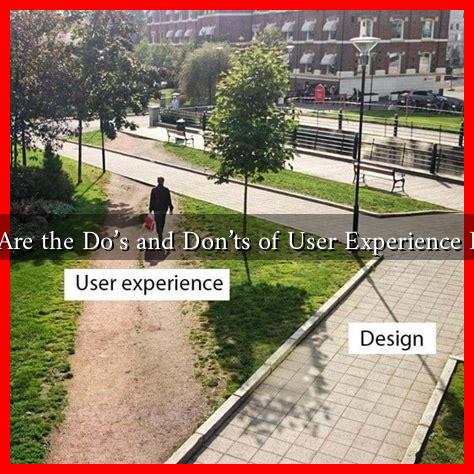-
Table of Contents
What Are the Do’s and Don’ts of User Experience Design
User Experience (UX) design is a critical aspect of creating digital products that are not only functional but also enjoyable to use. A well-designed user experience can significantly impact user satisfaction, retention, and overall success of a product. However, navigating the complexities of UX design can be challenging. This article outlines the essential do’s and don’ts of user experience design to help you create effective and engaging digital experiences.
The Do’s of User Experience Design
Implementing best practices in UX design can lead to a more intuitive and user-friendly product. Here are some key do’s to consider:
- Do Conduct User Research: Understanding your target audience is crucial. Conduct surveys, interviews, and usability tests to gather insights about user needs and preferences. For example, companies like Airbnb have successfully used user research to refine their platform based on real user feedback.
- Do Prioritize Usability: Ensure that your design is easy to navigate. Use clear labels, logical layouts, and intuitive controls. A study by the Nielsen Norman Group found that users often leave websites that are difficult to navigate, emphasizing the importance of usability.
- Do Focus on Accessibility: Design with inclusivity in mind. Ensure that your product is accessible to users with disabilities by following guidelines such as the Web Content Accessibility Guidelines (WCAG). This not only broadens your audience but also enhances the overall user experience.
- Do Use Consistent Design Elements: Consistency in design helps users understand how to interact with your product. Use a uniform color scheme, typography, and button styles throughout your interface. This approach is exemplified by Google’s Material Design, which promotes consistency across applications.
- Do Test and Iterate: UX design is an ongoing process. Regularly test your designs with real users and be open to feedback. Iteration based on user testing can lead to significant improvements in the user experience.
The Don’ts of User Experience Design
While there are many best practices to follow, there are also common pitfalls to avoid in UX design. Here are some key don’ts:
- Don’t Ignore User Feedback: Dismissing user feedback can lead to a product that does not meet user needs. Always listen to your users and make adjustments based on their experiences.
- Don’t Overcomplicate the Design: Avoid cluttering your interface with unnecessary elements. A clean and simple design helps users focus on the essential tasks. For instance, the success of Apple’s products can be attributed to their minimalist design philosophy.
- Don’t Neglect Mobile Users: With a significant portion of web traffic coming from mobile devices, it’s essential to design for mobile first. Ensure that your website or application is responsive and provides a seamless experience across all devices.
- Don’t Use Jargon: Avoid technical language or jargon that may confuse users. Use clear and straightforward language to communicate effectively with your audience.
- Don’t Forget About Loading Times: Slow loading times can frustrate users and lead to high bounce rates. Optimize images and streamline code to improve performance. According to Google, 53% of mobile users abandon sites that take longer than three seconds to load.
Case Studies and Statistics
Several companies have successfully implemented these do’s and don’ts in their UX design processes. For example, Dropbox focused on user research and usability testing, which led to a significant increase in user engagement and retention. Their user-centric approach allowed them to refine their onboarding process, making it easier for new users to understand the platform.
On the other hand, companies that have ignored these principles often face challenges. For instance, the infamous redesign of the Facebook News Feed in 2013 led to widespread user dissatisfaction due to its complexity and lack of clarity, resulting in a backlash that forced the company to revert to a more user-friendly design.
Conclusion
In conclusion, effective user experience design is a blend of understanding user needs, prioritizing usability, and continuously iterating based on feedback. By following the do’s and avoiding the don’ts outlined in this article, designers can create engaging and effective digital experiences. Remember, the ultimate goal of UX design is to make users feel valued and understood, leading to higher satisfaction and loyalty. For more insights on UX design, consider exploring resources from the Nielsen Norman Group, a leading authority in the field.


